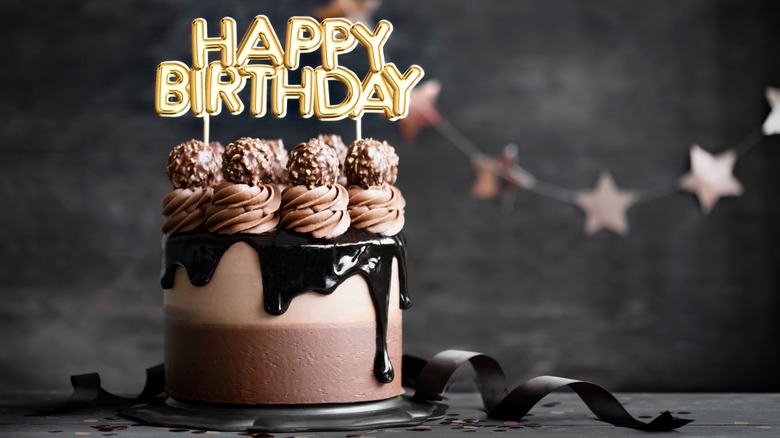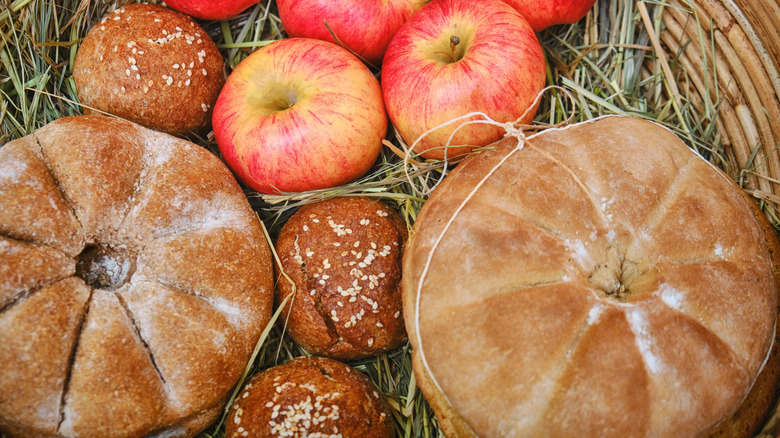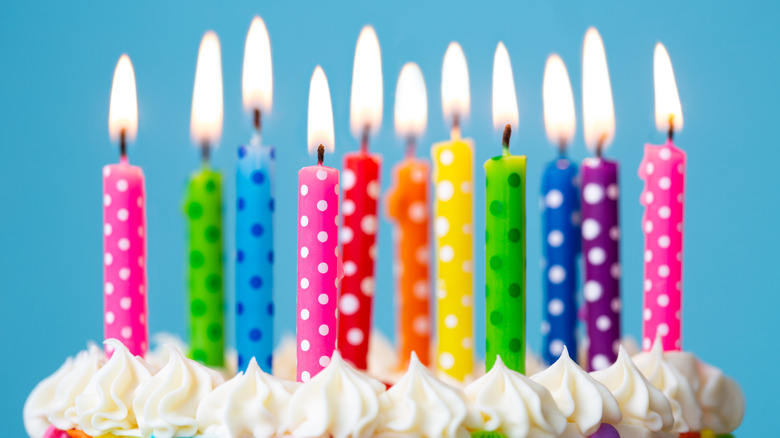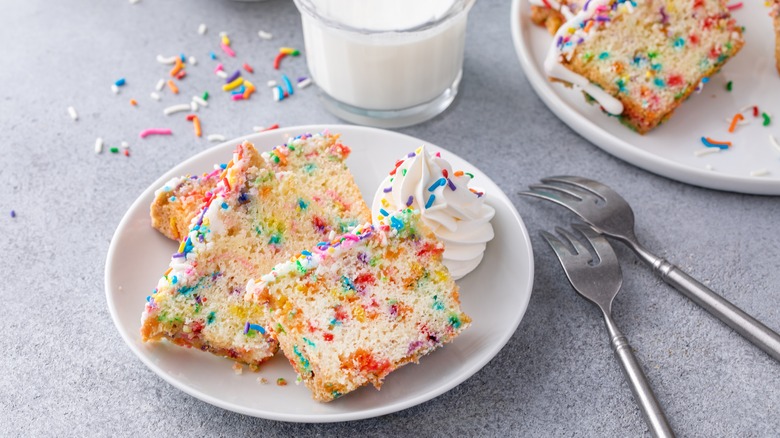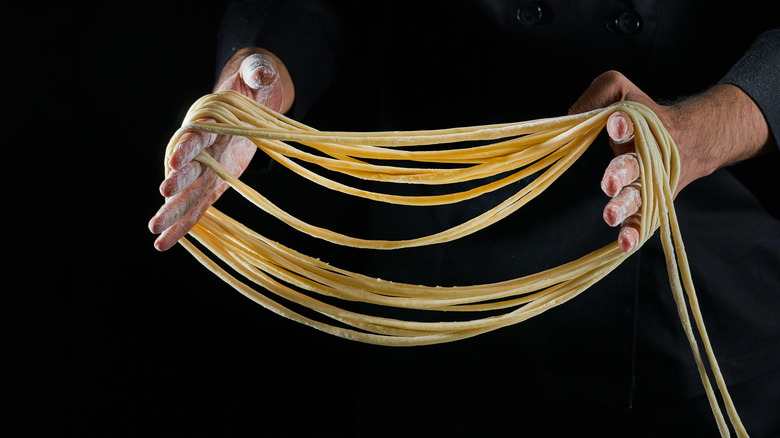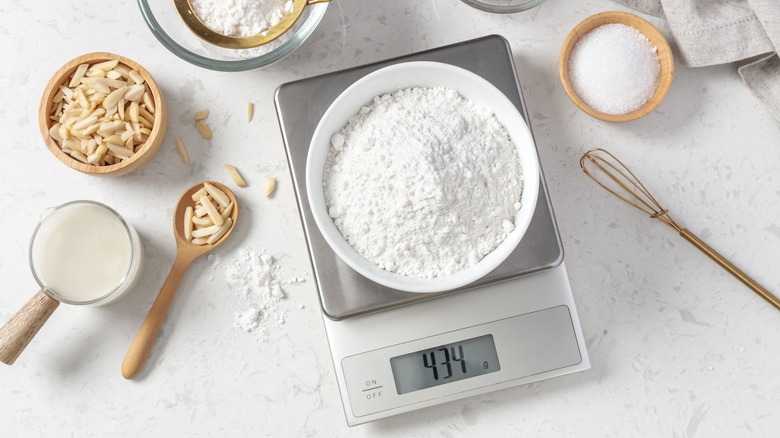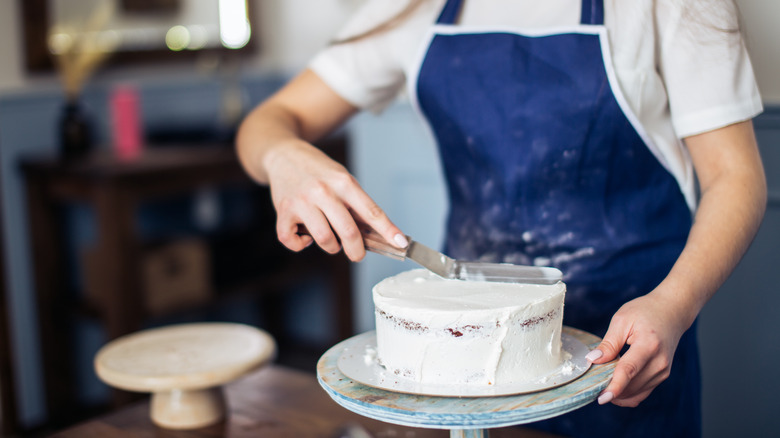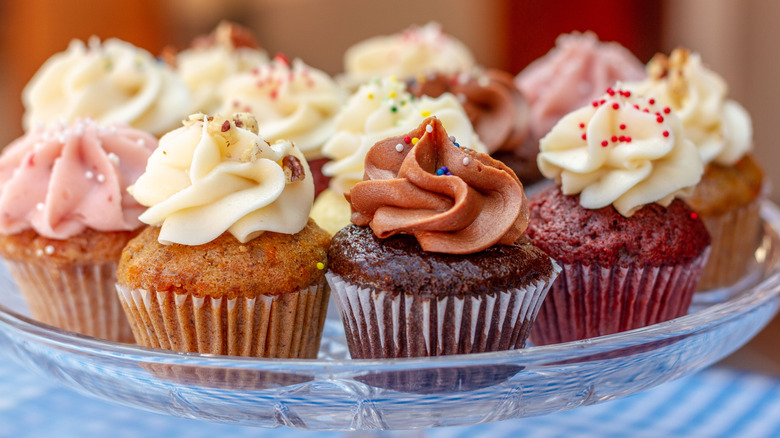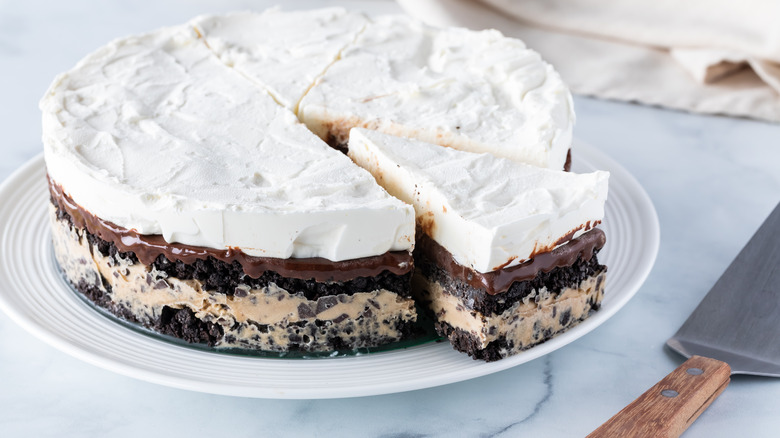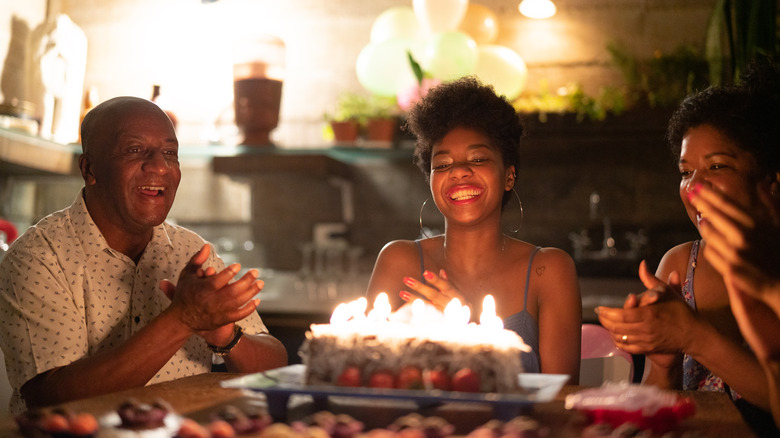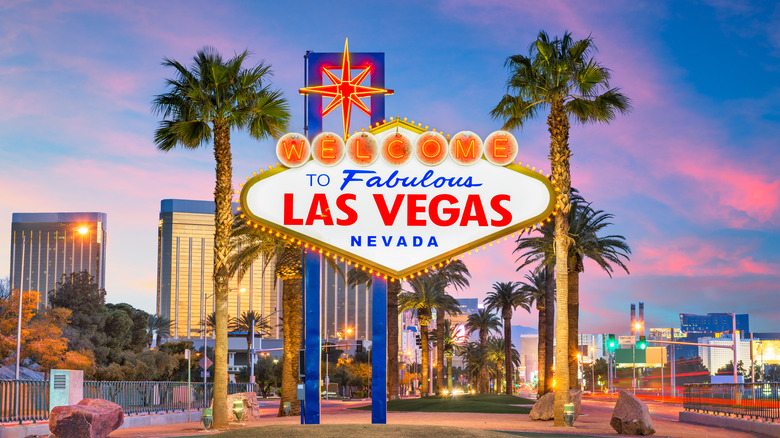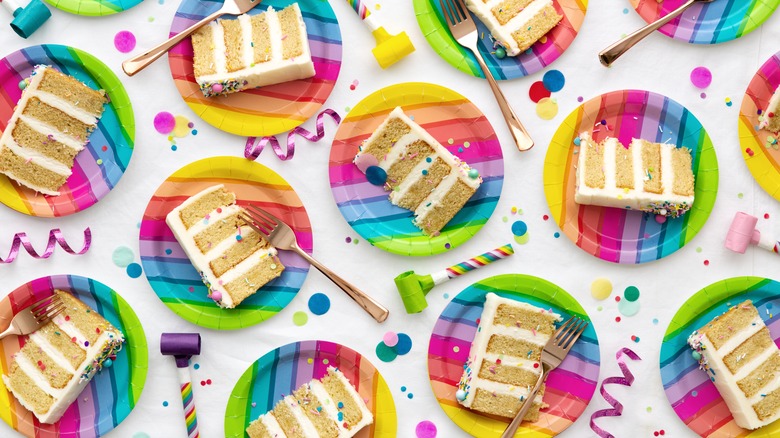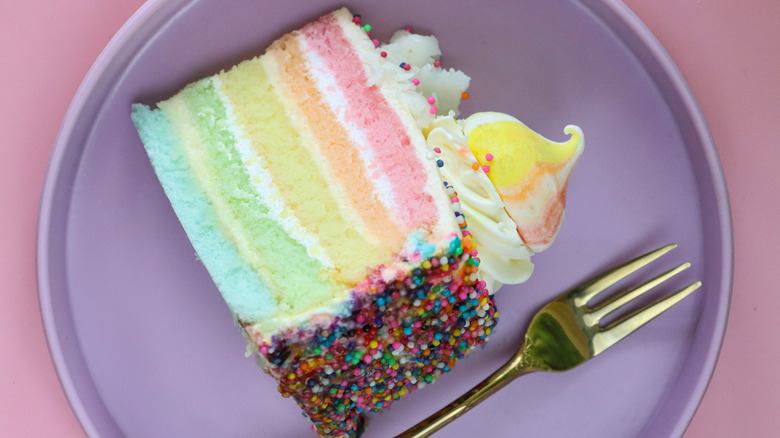12 Facts You Should Know About Birthday Cake
What's a birthday party without cake? This ubiquitous sweet treat is a must-have at most birthday celebrations, but there's much more to it than layers of cake and frosting. In the early days of the United States, cake was reserved for special occasions — and a birthday didn't usually make the cut. Ingredients like sugar were expensive and hard to come by, so celebratory cakes were instead sweetened with the addition of dried fruits. By the mid-20th century, fruit cake gave way to white cake, which then gave way to chocolate.
When it comes to birthday cakes today, if you can dream it, it can be done. Cakes are baked in every imaginable flavor; even boxed mixes span far beyond the standard chocolate and vanilla. Decorations range from the simple to the exquisite. No matter how you slice it, though, a birthday cake is the centerpiece of any celebration. Before you blow out the candles, brush up on birthday cake trivia that is sure to impress at your next party.
Birthdays — and birthday cake — used to only be for the wealthy
Birthday cake is an equal-opportunity treat in modern times but that wasn't always the case. Ancient Egyptians are credited with "inventing" the birthday celebration. They marked the coronation of the Pharaoh, as well as anniversaries of that coronation, in the same way they celebrated the birthdays of other gods. The Pharaoh's coronation was considered his "birth" as a god and complex traditions dictated when and how the passage of a Pharaoh's rule was marked.
In Ancient Rome, the wealthy celebrated their birthdays or closely associated "name days" with parties and cake, and artists created works to honor their patrons' birthdays. Little is known about whether the lower classes honored their own birthdays, but imperial birthdays were celebrated by the community as religious festivals — often for years after an emperor's death. These early yeasted cakes were sweetened with honey and studded with fruit and nuts. Cakes were left as offerings on family altars alongside wine and incense.
Candles are an Ancient Greek tradition
In Ancient Greece, cakes topped with candles were an offering to Artemis, the goddess of wild nature, the hunt, and is closely associated with the moon. According to ancient stories, this association with the moon led Greek people to bake cakes in her honor, topping them with lit candles to represent moonlight.
Today, birthday cakes are often topped with candles to represent a person's age, then blown out with a secret wish. This practice may have originated in Germany. In 1746, Andreas Frey observed Count Ludwig Von Zinzendorf's birthday celebration, noting that the event featured a large cake topped with candles according to the person's age, plus one candle in the middle. By the 18th century, a candle topped with cakes was a cornerstone of German children's birthdays or Kinderfeste. Candles were lit when the child woke in the morning, and they were continually replaced and relit throughout the day until the cake was eaten after dinner.
Chocolate is not the most popular cake flavor — and neither is Funfetti
Close your eyes and imagine a birthday cake. What do you see? We're willing to bet you're picturing chocolate or vanilla cake, layered with buttercream frosting and topped with rosettes and candles. This might be the most popular image of a birthday cake, but you may be surprised to learn that neither chocolate nor vanilla is actually the most popular cake flavor in the United States!
In 2022, jeweler Shane Co. collected data about the most popular cake flavors in the U.S., based on 12 months of Google searches. Instead of a clear winner, the results showed that 21 flavors reigned across 50 states. Yes, chocolate and Funfetti cake cracked the top five, but classic white and butter cakes were only ranked first in one state each — Ohio and Missouri, respectively.
So, what was the big winner? Ice cream cake was named the most popular cake flavor in Arizona, Illinois, Maryland, Massachusetts, Michigan, Nevada, New Jersey, Oregon, Pennsylvania, and Washington. Which flavors of ice cream, you might ask? Well, that's up to another survey.
You might not get a cake if you're celebrating your birthday abroad
If you're getting another year older in another country, the traditional food to mark your celebration might not be cake at all. In Australia, children celebrate with a totally charming treat called Fairy Bread. Sliced white bread is topped with butter and then covered with rainbow nonpareil sprinkles, known as hundreds and thousands in Australia.
In Korea, the celebrant sips seaweed soup, called miyeokguk. The soup is given to mothers who are breastfeeding and is again served on a person's birthday to honor their mother's work in carrying and raising them. In China, longevity noodles are served on birthdays as well as during the New Year. The cook pulls a single, incredibly long noodle to symbolize and bring about a long life for the eater. It is even more auspicious if the eater can eat the entire noodle without biting it.
A party needs celebratory sweets, and in Brazil, nothing is more popular than brigadeiros, made with sweetened condensed milk, butter, cocoa powder, and sprinkles. Birthdays in Sweden are often marked in a royal fashion with a princess cake. First created in the early 20th century, a Swedish princess cake recipe layers sponge, pastry cream, and jam under a dome of green-tinted marzipan.
You don't need specialty tools to make a fantastic cake at home
Grocery store birthday cakes are quick, convenient, and delicious, and cakes from specialty bakeries are guaranteed to wow your guests. But a homemade birthday cake is made with love, is less expensive, and can be just as impressive, as long as you have the right tools.
The most important baking tool (that you probably already have) is a kitchen scale. According to celebrity pastry chef Duff Goldman, a scale ensures super-precise measurements. Scooping a cup of flour can range from 180 to 210 grams of flour, a vast difference that will impact the texture. Use your scale when divvying the batter between cake pans to ensure even layers.
For smooth frosting and easy assembly, turn to your freezer. Bake your cake the night before (or even a few days before!) and allow it to cool completely. Wrap it tightly in multiple layers of plastic wrap, then freeze it flat. When you're ready to decorate, assemble them while the layers are still frozen. The layers won't crack as you handle them, and you'll have fewer crumbs in your crumb coat. Be sure to put the cake back in the fridge to let the crumb coat set before applying the outer layer of frosting.
For super smooth frosting, use a bench scraper. Once you've applied the frosting, hold the bench scraper vertically against the edge of the cake to smooth any rough or lumpy spots.
Frosting and icing are not the same
Every great cake has a delicious topping, but what is it you're topping your cake with? While frosting and icing are often used interchangeably, the two sweet condiments are actually not the same.
Frosting is a thick, creamy substance (usually made of butter and sugar) that is whipped to be light, airy, and fluffy. This is what you should use to cover an entire cake or a batch of cupcakes. Icing, on the other hand, is much thinner. It is more often a combination of powdered sugar and liquid, like milk. Depending on the consistency of the icing, it can be piped, drizzled, flooded (like on sugar cookies), or used to affix decorations (such as on a gingerbread house).
While these two cake toppings aren't the same, many birthday cakes will feature both. The cake will first be coated with frosting and then might be draped in fondant (a type of icing) or decorated with intricate icing designs.
Cupcakes are an American invention
Cupcakes are an iconic birthday treat in the United States, which makes sense because they're an American creation. The first mention of cake baked in a cup was in "American Cookery" by Amelia Simmons, published in 1796. Eliza Leslie also included cupcakes in "Seventy-five Receipts for Pastry, Cakes, and Sweetmeats" in 1828.
Of course, modern cupcakes aren't baked in teacups. Today, they're baked in paper or aluminum liners and have expanded from homemade treats to widely available desserts. Bakeries such as Magnolia, Sprinkles, and Georgetown Cupcakes are household names. Sprinkles even offers cupcakes via 50 cupcake ATMs around the country.
In 2011, Georgetown Cupcakes set a record by baking the world's largest cupcake. According to the Guinness Book of World Records, the cupcake was 56 inches in diameter, 36 inches tall, and weighed 2,594 pounds. The company created a custom oven and pan in order to bake the giant cupcake, and they used Jawbreaker candies as oversized sprinkles.
You can thank Victorian-era cooks for ice cream cake
Anyone with a summer birthday knows there's nothing quite like an ice cream cake. How can you beat layers of cool ice cream, crunchy cookies, and creamy whipped frosting on a hot day?
Ice cream cake might conjure images of Fudgie the Whale or a mix-in-filled Cold Stone creation, but it has a surprisingly proper predecessor: The English trifle. Trifles are popular Renaissance desserts that layer leftover bits of cake, fruit, and custard in a bowl, where the custard (and sometimes alcohol) softens the stale cake. Of course, if you freeze custard you get ice cream, so it's no surprise the habit of layering it with cake continued once cooks in Victorian England started chilling their custards.
Commercially available ice cream cakes really took the world by storm when Carvel created Cookie Puss in 1972 and Fudgie the Whale in 1977. Today, Carvel offers dozens of ice cream cake shapes and flavors, as do shops like Ben & Jerry's, Cold Stone Creamery, and even your local grocery store.
The birthday song has a very contested history
What better song to sing with birthday cake than "Happy Birthday to You?" Well, according to some contested and confusing history and copyright law, if you sang "Happy Birthday" before 2015 you may have owed someone royalties.
In 1893, sisters Mildred and Patty Hill, both educators, wrote a song called "Good Morning to All" — the tune of which is now associated with "Happy Birthday." The sisters assigned the copyright of the tune to their publishers, and it was eventually acquired by Clayton F. Summy Co. The birthday lyrics appeared in print in the early 1900s, and a few copyright cases were brought through the early- to mid-20th century. When Warner-Chapell Music Group acquired the song in 1989 it really made headlines.
Don't worry, you're in the clear. In 2015, a Los Angeles judge threw it all out. Judge George H. King ruled that Summy had never properly gotten the copyright in the first place, which means Warner-Chapell could never have purchased it. And since it's been over a century since the tune and lyrics first appeared, everything is officially in the public domain. Sing away!
The largest birthday cake ever made was 23 million calories
They say the house always wins, and the same is true in the race for the biggest birthday cake. When Las Vegas turned 100 in 2005, bakers showed up to ensure Sin City celebrated with the largest birthday cake ever made.
After over 30,000 vanilla half-sheet cakes were baked in North Carolina at the Sara Lee bakery, the cake was trucked to Las Vegas. Around 1,000 volunteers came together to assemble the seven-layer cake, which wound up being 102 feet long and 52 feet wide. Once the frosting was added — including a massive representation of Las Vegas' iconic welcome sign — the cake clocked in at 130,000 pounds and over 23 million calories. It took over 14 hours to assemble.
Thousands of guests were invited to enjoy the cake, but with a cake larger than a basketball court, there were a lot of leftovers. The remaining cake was donated to local farms as pig food, which likely resulted in some super tasty ham and bacon.
There is a right way to cut a round birthday cake
It's time to cut the cake, but did you know there's actually a "right" way to do it? Depending on the size of your crowd, how you cut the cake makes all the difference. For smaller groups, wedges are great. Use the knife to mark a line across the middle of the cake to help you create even slices, dividing the cake into segments. Be sure to wipe the frosting from the knife after each slice to get a clean cut. For the easiest serving, do all the slicing before you remove a piece.
To stretch a small round cake for a larger group, take inspiration from wedding cakes. Starting at one side of the cake, cut a slab about one inch thick. Remove the slab to a cutting board, then divide it vertically into one- to two-inch rectangular slices. Continue as you work your way across the cake, getting neat pieces instead of messy and crumbling slivers.
Leftover cake freezes like a dream
Have you been blessed with leftover birthday cake? Don't leave it on the counter to get stale! Instead, store it properly to turn birthday cake into a gift that keeps on giving.
Whole or large pieces of cake can be easily frozen. Place the cake, still on the cake board, in the freezer so that it isn't touching anything else. Allow it to freeze solid, then wrap the cake tightly in multiple layers of plastic wrap. Follow with a layer of foil, then place it back in the freezer to store. Let the cake defrost at room temperature for two to three hours before enjoying.
Of course, once it is no longer your birthday you probably don't need an entire cake. Instead, freeze individual slices for an easy after-dinner treat! Slice the cake into wedges or rectangles, then lay them on a sheet pan that has been prepped with parchment paper. Freeze the slices until they are solid, then individually wrap them in plastic. Enjoy cold or give them 10-20 minutes on the counter before digging in.
